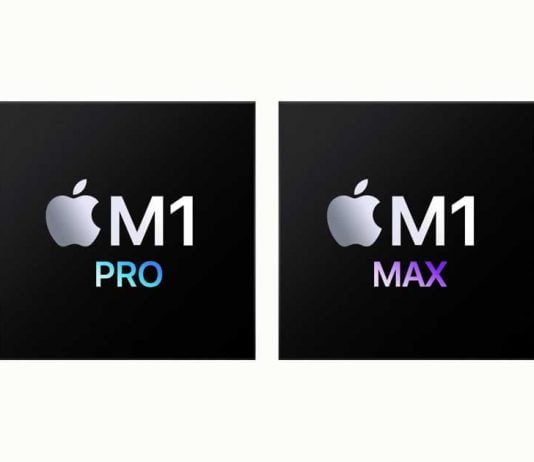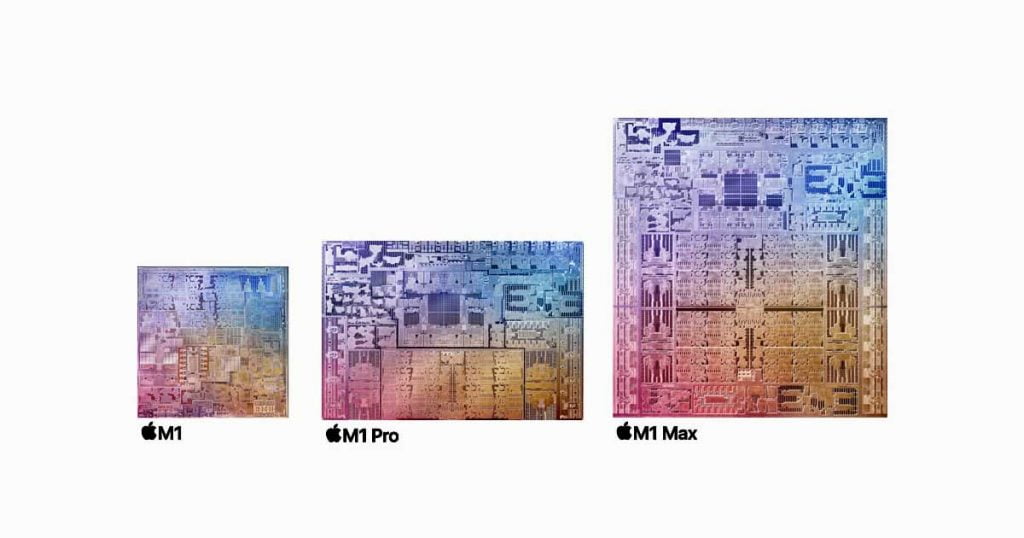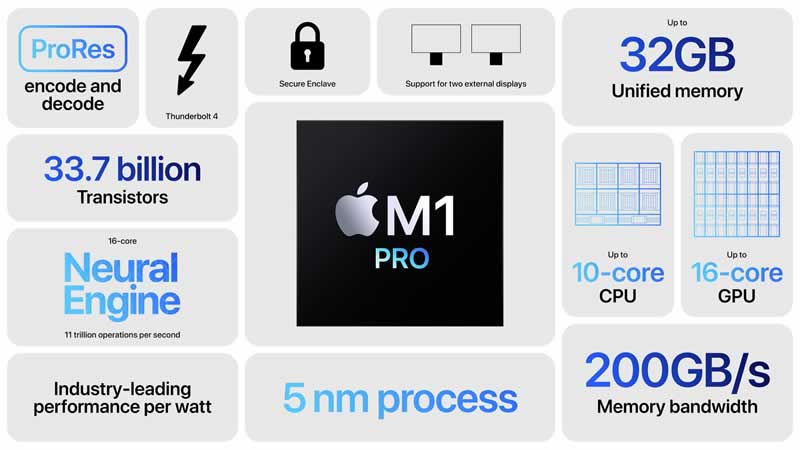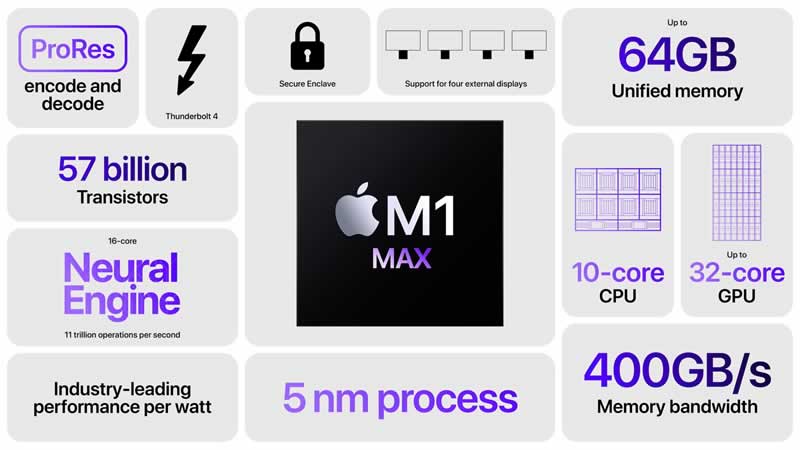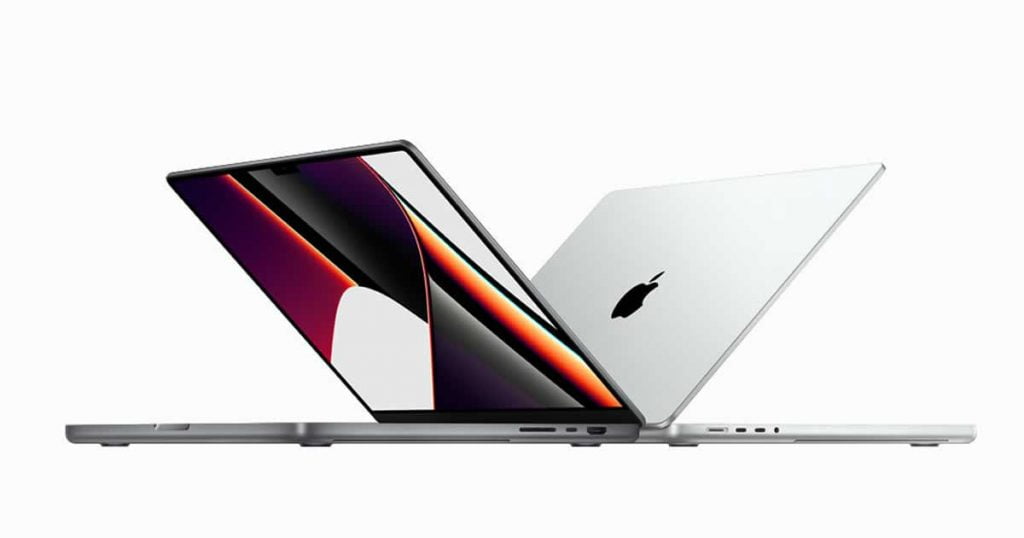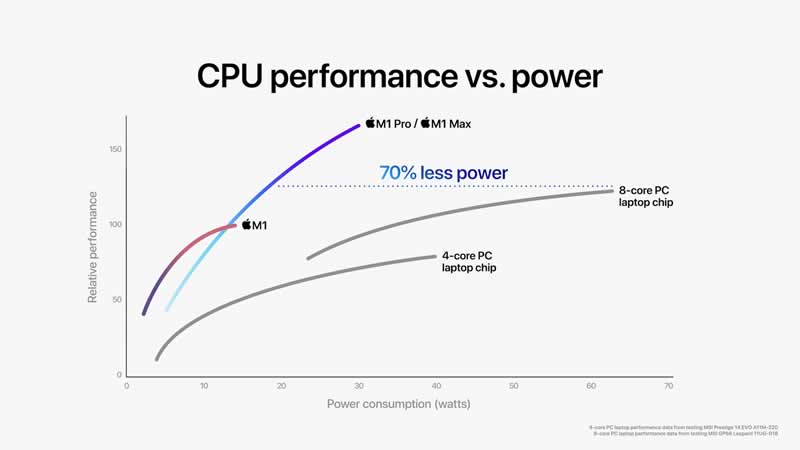Apple has presented its new proprietary M1 Pro and M1 Max chips on its Unleashed event, the first to be manufactured for its computers intended for professional users.
With the M1 Pro and M1 Max, the new MacBook Pros in 14.2 and 16.2 inches are the first notebooks to be upgraded from last year’s M1. Twice as many performance cores meet clearly drilled GPU. There are also more RAM and SSD options, more connections, MagSafe, and mini LED displays with 120 Hz.
Regardless of whether AMD, Intel or Nvidia hardware, with the M1 Pro and the M1 Max, Apple is preparing to outdo the assembled competition. The company ensures that both the M1 Pro and the M1 Max give a performance 1.7 higher than that of a PC with an eight-core chip from the competition.
Apple M1 Pro
While the M1 previously had 4 performance and 4 efficiency cores, the new M1 Pro has up to 8 performance and 2 efficiency cores. Apple has also tripled the memory bandwidth to 200 GB / s and doubled the maximum amount of memory supported to 32 GB according to the newer LPDDR5-6400 standard.
SSDs up to 7.4 GB/s speed can be selected with up to 8 TB. The new CPU is supported by a GPU doubled from 8 to 16 cores, which has up to 2,048 execution units and a performance of up to 5.2 TFLOPS. The M1 Pro also offers a new media engine for hardware-accelerated decoding and encoding of H.264, HEVC, ProRes and ProRes RAW. There is a decoding and an encoding engine as well as a ProRes encoding and decoding engine. The M1 Pro comes from 5 nm production and has 33.7 billion transistors.
A smaller variant of the M1 Pro with only 8 CPU and 14 GPU cores was not mentioned in the stream, but this can be found in the technical data of the MacBook Pro 14.2.
Apple M1 Max
Above the M1 Pro, the company positions the M1 Max with 57 billion transistors from 5 nm production. The CPU resembles the full configuration of the M1 Pro, but the additional die area flows into a GPU that has again been doubled to up to 32 cores with up to 4,096 execution units and up to 10.4 TFLOPS performance.
At 400 GB/s, the chip’s memory bandwidth is six times the level of the M1 and up to 64 instead of 32 GB LPDDR5-6400 come next to the die. The media engine, which in the M1 Max still has one decoding, but two encoding and two ProRes encoding and decoding engines, has also been drilled out further.
Similar to the M1 Pro, smaller models of the M1 Max were not mentioned in the stream. Apple always offers the more powerful SoC with the same CPU but differentiates the GPU in variants with 24 and 32 cores.
MacBook Pro
With regard to its aesthetic redesign, the new MacBook Pro arrive in sizes of 14 and 16 inches, they do so with a very high-resolution screen thanks to mini-LED technology and that takes more advantage of the front with narrower frames and a notch where it houses a 1080p camera. Also, a better keyboard that says goodbye to the Touch Bar and the most connectivity to date on a MacBook Pro.
The extreme SoC performance is designed to facilitate 3D artists’ work in 8K greatly, and doing extremely heavy tasks previously unimaginable on a laptop. In addition, they will do so without sacrificing battery life, since the new chips allow them to offer up to 17 hours of video playback in the 14-inch model (that is, 7 hours more), while the 16-inch model reaches 21 hours of playback, that is, 10 more hours.
The thermal performance is also accompanied by its internal design. Apple explains that its new aluminium casing precisely surrounds an advanced thermal system that can displace 50% more air than the previous generation, even at low fan speeds.
In the new case, you also have the most connectivity ever seen in a MacBook. Both models come with three Thunderbolt 4 ports for connecting high-speed peripherals, an SDXC card slot, an HDMI port, an improved audio jack compatible with high-impedance headphones and the new generation of MagSafe that now sports a new design.
In addition, for the first time on the Mac, you can use fast charging, which allows you to reach 50% charge in just half an hour. With the M1 Pro chip, users can now connect up to two Pro Display XDRs, and with the M1 Max, up to three Pro Display XDRs and a 4K monitor all at once.
The new MacBook M1 Pro and M1 Max equip a Liquid Retina XDR display that, thanks to the mini-LED technology already used in the iPad Pro , provides up to 1,000 nits of sustained brightness at full screen, 1,600 nits of maximum brightness and contrast of 1,000,000:1.
In addition, the screen of this new Mac includes ProMotion technology, with an adaptive refresh rate of up to 120 Hz. ProMotion is the system that automatically modifies the refresh rate to adapt it to the content that the user has on screen and thus help preserve the battery.
Regarding availability and price, the MacBook Pro models with M1 Pro and M1 Max are pre-order now and will be available starting Tuesday, October 26. The 14-inch MacBook Pro starts at $2,249, and the 16-inch MacBook Pro starts at $2,749.


